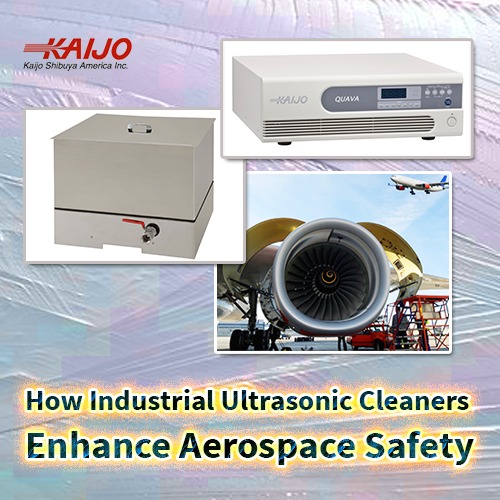Industrial Ultrasonic Cleaners for Aerospace Safety
April 17, 2018
 Aerospace parts for rockets and aircraft require periodic cleaning to maintain their functionality. Cleaning has to be thorough and complete to ensure parts don’t fail during operation or compromise the safety of passengers and crew. Removal of deposits and contaminants using traditional cleaning methods can stress the aerospace parts and reduce their lifetime or affect their ability to withstand the temperatures and pressures common in aerospace operation. Industrial ultrasonic cleaners offer an attractive alternative that cleans quickly and effectively with reduced part stress.
Aerospace parts for rockets and aircraft require periodic cleaning to maintain their functionality. Cleaning has to be thorough and complete to ensure parts don’t fail during operation or compromise the safety of passengers and crew. Removal of deposits and contaminants using traditional cleaning methods can stress the aerospace parts and reduce their lifetime or affect their ability to withstand the temperatures and pressures common in aerospace operation. Industrial ultrasonic cleaners offer an attractive alternative that cleans quickly and effectively with reduced part stress.
How Ultrasonic Cleaners Work
Ultrasonic cleaning systems are made up of an ultrasonic generator, transducers and a cleaning tank. The generator produces a high-frequency electric signal at the operating frequency of the system and with the required power. The transducers are immersed in the cleaning solution and convert the electric signal into sound waves inside the cleaning tank. The cleaning solution can include a mild detergent or solvent, but even plain water is effective for many cleaning applications.
When the ultrasonic sound waves travel through the cleaning solution, they produce pressure peaks and troughs. Microscopic cavitation bubbles are created in the pressure troughs and collapse in the peaks. When a cavitation bubble collapses, it produces a powerful jet that dislodges contaminants from the parts to be cleaned and removes dirt down to the original surface of the parts. Ultrasonic cleaning is gentle and environmentally benign.
Advantages of Changing to Ultrasonic Cleaners
Traditional cleaning methods for aerospace parts include soaking in aggressive chemicals, manual scrubbing and pressure washing. Often the cleaning methods are highly specialized and parts have to be shipped off site to precision cleaning facilities at substantial costs. Even then, cleaning inaccessible holes, interior surfaces and rough parts can be challenging. With heavy contamination, aggressive cleaning can damage parts or leave them unsuitable for further safe use.
High Performance Industrial ultrasonic cleaners provide effective and comprehensive cleaning for a diverse range of cleaning applications. For rugged parts, lower frequencies can deliver robust cleaning action with larger cavitation bubbles and powerful cleaning action. For delicate parts, higher frequencies operate with smaller bubbles and clean more gently. Ultrasonic cleaning systems can deliver exactly the strength of cleaning action needed.
While the cleaning action can be calibrated to the requirements of the application, cleaning is comprehensive in that it takes place wherever cleaning solution is present. The cleaning bubbles appear and act inside pipes, through holes and in crevices. All surfaces are cleaned quickly and completely.
For example, removing carbon deposits from a jet engine nozzle using traditional cleaning methods can be difficult. The nozzle may have to be shipped to a dedicated cleaning facility that has the capability to work with harsh chemicals and to inspect the results. The nozzle may have to be scrubbed inside and out while inaccessible interior areas have to be soaked, inspected, and possibly soaked some more. If the aggressive cleaning results in scratches or the wearing of surfaces that have to conform to tight tolerances, the nozzle may have to be scrapped or re-machined.
With ultrasonic cleaning, the nozzle can be placed in an ultrasonic cleaning tank onsite and cleaned inside and out, including inaccessible areas, usually in less than an hour. There is no possibility of scratching or wearing part surfaces and the deposits are removed completely the first time. The process is quick and saves money.
Safety Benefits
When parts are not stressed during the cleaning process, aerospace safety increases. During cleaning by means of harsh chemicals, scrubbing and pressure washing, parts may suffer damage that remains undetected. When such damage results in part failure, the consequences in aerospace applications can include catastrophic failure and possible loss of life. A correctly designed ultrasonic cleaning system does not stress the parts, and such damage is excluded.
Kaijo has a complete line of industrial ultrasonic cleaners along with the experience to supply systems for specific aerospace part cleaning applications. The company can advise on the type of system, frequency and power required to ensure the right system is used for a customer’s specific cleaning application.





